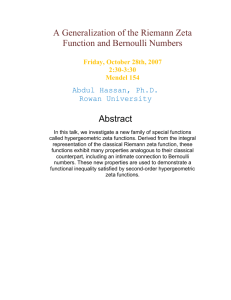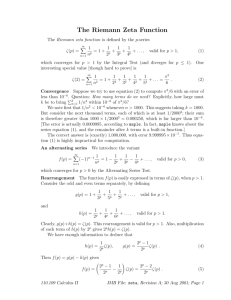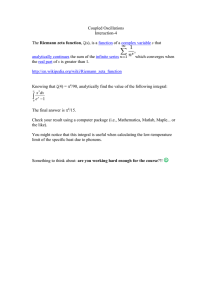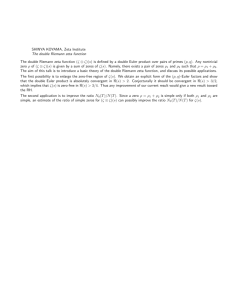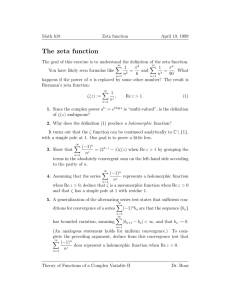A New Accurate Analytical Expression for Rise Time Intended for
advertisement
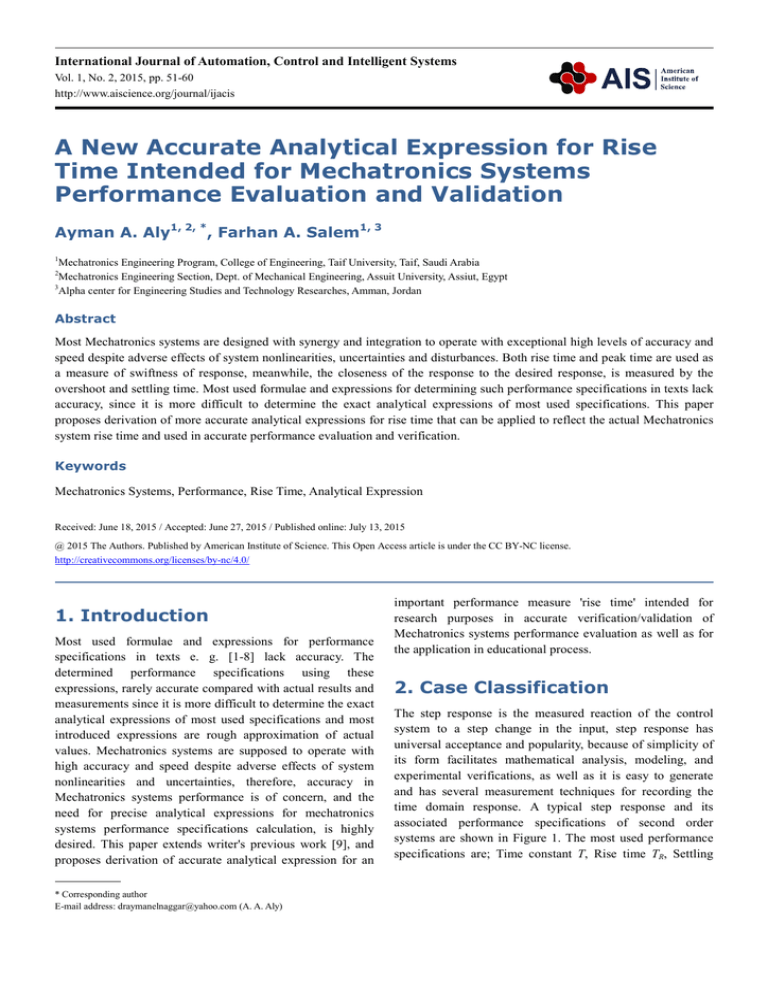
International Journal of Automation, Control and Intelligent Systems
Vol. 1, No. 2, 2015, pp. 51-60
http://www.aiscience.org/journal/ijacis
A New Accurate Analytical Expression for Rise
Time Intended for Mechatronics Systems
Performance Evaluation and Validation
Ayman A. Aly1, 2, *, Farhan A. Salem1, 3
1
Mechatronics Engineering Program, College of Engineering, Taif University, Taif, Saudi Arabia
Mechatronics Engineering Section, Dept. of Mechanical Engineering, Assuit University, Assiut, Egypt
3
Alpha center for Engineering Studies and Technology Researches, Amman, Jordan
2
Abstract
Most Mechatronics systems are designed with synergy and integration to operate with exceptional high levels of accuracy and
speed despite adverse effects of system nonlinearities, uncertainties and disturbances. Both rise time and peak time are used as
a measure of swiftness of response, meanwhile, the closeness of the response to the desired response, is measured by the
overshoot and settling time. Most used formulae and expressions for determining such performance specifications in texts lack
accuracy, since it is more difficult to determine the exact analytical expressions of most used specifications. This paper
proposes derivation of more accurate analytical expressions for rise time that can be applied to reflect the actual Mechatronics
system rise time and used in accurate performance evaluation and verification.
Keywords
Mechatronics Systems, Performance, Rise Time, Analytical Expression
Received: June 18, 2015 / Accepted: June 27, 2015 / Published online: July 13, 2015
@ 2015 The Authors. Published by American Institute of Science. This Open Access article is under the CC BY-NC license.
http://creativecommons.org/licenses/by-nc/4.0/
1. Introduction
Most used formulae and expressions for performance
specifications in texts e. g. [1-8] lack accuracy. The
determined performance specifications using these
expressions, rarely accurate compared with actual results and
measurements since it is more difficult to determine the exact
analytical expressions of most used specifications and most
introduced expressions are rough approximation of actual
values. Mechatronics systems are supposed to operate with
high accuracy and speed despite adverse effects of system
nonlinearities and uncertainties, therefore, accuracy in
Mechatronics systems performance is of concern, and the
need for precise analytical expressions for mechatronics
systems performance specifications calculation, is highly
desired. This paper extends writer's previous work [9], and
proposes derivation of accurate analytical expression for an
* Corresponding author
E-mail address: draymanelnaggar@yahoo.com (A. A. Aly)
important performance measure 'rise time' intended for
research purposes in accurate verification/validation of
Mechatronics systems performance evaluation as well as for
the application in educational process.
2. Case Classification
The step response is the measured reaction of the control
system to a step change in the input, step response has
universal acceptance and popularity, because of simplicity of
its form facilitates mathematical analysis, modeling, and
experimental verifications, as well as it is easy to generate
and has several measurement techniques for recording the
time domain response. A typical step response and its
associated performance specifications of second order
systems are shown in Figure 1. The most used performance
specifications are; Time constant T, Rise time TR, Settling
52
Ayman A. Aly and Farhan A. Salem: A New Accurate Analytical Expression for Rise Time Intended for Mechatronics
Systems Performance Evaluation and Validation
time Ts, Peak time, TP, Maximum overshoot MP, Maximum
undershoot Mu, Percent overshoot OS%, Delay time Td, The
decay ratio DR , Damping period TO and frequency of any
oscillations in the response, the swiftness of the response and
the steady state error ess.
Figure 1.
1 Second-order underdamped response specifications [9].
2.1. Rise Time TR
In control theory applications, rise time is defined as "the
time required for the response to rise from x% to y% of its
final value", with 0%-100%
100% rise time common for
underdamped second order systems, 5%-95%
95% for critically
damped and 10%-90% for overdamped [10].
[
The transient
response of the system may be described in terms of two
factors; a) The swiftness of response, as represented by the
rise time and the peak time. b) The closeness of the response
to the desired response, as represented by the overshoot and
settling time. Therefore, the rise time yields information
about the speed of the transient response.
se. This information
can help a designer determine if the speed and the nature of
the response do or do not degrade the performance of the
system [11]. It is, for example determines speed of rise of
flow or pressure (e.g. volume or pressure control modes)
2.2. Rise Time for First Order Systems
First order systems without zeros and systems that can be
approximated as first order systems are described by first
order differential equation and transfer function,
function derived as
given by Eq. (1). As shown in Figure 2,
2 the response is
characterized by time constant T, rise time TR, settling time Ts
and steady state error ess, where the only parameter required
to characterize response is time constant T, and when first
order system is subjected to a unity step input,
input R(s) = 1/s, as
by Eq. (2) the
he response for these systems is either natural
decay or growth generated by the system pole:
pole
d
x(t ) + b⋅ x(t ) = u (t )
dt
a⋅ sX ( s ) + b ⋅ X ( s ) = U ( s )
a⋅
a
1
X ( s ) ⋅ s + 1 = U ( s )
b
b
1
X ( s ) [Ts + 1] = U ( s )
b
K
X (s) 1 / b
G(s) =
=
= DC
U (t ) Ts + 1 Ts + 1
C (s) = R(s) * G( s) =
1 K DC
s Ts + 1
(1)
(2)
Taking the inverse transform, the (solution) step response is
given by Eq. (3). Rise time is found by solving Eq. (3) for the
difference in time, e.g. rise time for 10% to 90% criterion is
found by solving Eq. (3)) for the difference in time at c(t) =
0.9 and c(t) = 0.1, as given by Eq.(4)
c ( s ) = 1 − e −α t
(3)
TR = (1 − e −α t90 ) − (1 − e −α t10 )
TR =
2.3026 0.1054 2.1972
−
=
a
a
a
(4)
International Journal of Automation, Control and Intelligent Systems Vol. 1, No. 2, 2015, pp. 51-60
The rise time can be measured in terms of the time constant,
and given by Eq. (5):
t90
t10
TR = (1 − e T ) − (1 − e T ) = 2.3026T − 0.1054T = 2.1972T (5)
Figure 2 (a). First order system response to step, and performance specifications.
Step Response
25
20
Amplitude
15
10
5
Time constant,T
0
0
20
Rise time, Tr
40
53
60
Settling time, Ts
80
100
Time (sec)
Figure 2 (b). Performance specifications of first order PMDC motor step response.
5T
120
54
Ayman A. Aly and Farhan A. Salem: A New Accurate Analytical Expression for Rise Time Intended for Mechatronics
Systems Performance Evaluation and Validation
2.3. Rise Time for Second Order System
For second order systems, and systems that can be
approximated as second order systems, when subjected to
step input, R(s) = A/s, the response depends on pole location
on complex plan given by Eq. (6), that in turns, depends on
damping ratio ζ, and undamped natural frequency ωn, where
damping ratio determines how much the system oscillates as
the response decays toward steady state and undamped
natural frequency ωn, determines how fast the system
oscillates during any transient response, based on this, there
are four cases of stable response to consider; undamped,
underdamped, critically damped and overdamped response.
P = −ξω n ± jω n 1 − ξ 2
(6)
For underdamped case; 0<ζ<1 and two complex conjugate
poles given by Eq.(6), allow us to rewrite general form of
second order system to have the form given by Eq.(7). To
obtain inverse Laplace transform we need to expand by
partial fractions and solve, this all gives:
ωn2
ωn2
C ( s)
= 2
=
2
2
R(s) s + 2ξωn s + ωn (s + ξωn + j 1 − ξ )(s + ξωn − j 1 − ξ 2 )
(7)
ωn2
C ( s) 1
=
⇒
2
R( s ) s ( s + 2ξωn s + ωn2 )
=
=
s + 2ξωn
s 2 + 2ξωn s + (ωn 1 − ξ 2 ) 2
s + 2ξωn
s 2 + 2ξωn s + (ωn 1 − ξ 2 ) 2
+
+
s + 2ξωn
1
1
=
+
s s 2 + 2ξωn s + ωd 2 s
s + 2ξωn
1
1
=− 2
+
s
s + 2ξωn s + ωd 2 s
ξω
ωd
s + 2ξωn
1
= −
− n
2
2
ωd ( s + ξωn ) 2 + ωd 2
s ( s + ξωn ) + ωd
ωd
s + 2ξωn
ξ
1
= −
−
2
2
s ( s + ξωn ) 2 + ωd 2
1 − ξ 2 ( s + ξωn ) + ωd
ξ
1− ξ 2
c (t ) = 1 −
1
1− ξ 2
1
sin ωd t )
1− ξ 2
e −ξωn t cos(ωd t − φ )
(8)
cos ω d TR +
tan ω d TR = −
(9)
TR =
e
− ξω n t
ξ
1− ξ 2
sin ωd TR ) = 1
(11)
Since e −ξωnTR ≠ 0 , we have:
This can be rewritten to have the following forms:
c(t ) = 1 −
It is difficult to determine precise analytical expressions for
rise time TR[11] for second order systems. Different
approximate formulae for the rise time appear in different
texts[1-8]. One reason for that is because of different
definitions of the rise time [7], as well as the required
accuracy. An alternative measure to represent the rise time is
as the reciprocal of the slope of the step response at the
instant that the response is equal to 50% of its final value
[3][9], that is at delay time TD. The exact values of rise time
for given range of damping ratio, can be determined directly
from the responses of Figure 1, or rise time is found by
solving Eq. (8) for the difference in time e.g. rise time for
10% to 90% is found by solving Eq. (8) for the difference in
time at c(t) = 0.9 and c(t) = 0.1. For underdamped case; 0%
to 100% of its final value, the rise time can be obtained by
equating Eq.(8) with unity and solve for time t, that is rise
time, this shown in equations below. Also MATLAB code
can be written to return actual values of rise time, and plot it
again given range of zetas, an example code, is written and
applied in this paper.
c(t ) = 1 − e −ξωnTR (cos ωd TR +
Taking inverse Laplace transform, gives:
c(t ) = 1 − e−ξωnt (cos ωd t +
depends on damping ratio ζ and undamped natural frequency
ωn . Plots of the step response as functions of the normalized
time ωnt for various damping ratio values of 0 ≤ ζ ≤1.5 are
illustrated in Figure 3 (a), the curves show that he response
becomes more oscillatory as ζ decreases in value, up to ζ=1,
when ζ ≥ 1, the step response does not exhibit any overshoot
or oscillatory behavior, also when ζ between 0.5 and 0.8 the
system reaches final value more rapidly. Plots of the step
response for various ωn are illustrated in Figure 3 (b), the
responses show that ωn has a direct effect on the rise time,
delay time, and settling time but does not affect the overshoot
[9].
sin(ω d t + cos ξ )
−1
(10)
Eq.(8),(9)and(10) show that the damped natural frequency ωd,
given by ωd = ωn 1 − ζ 2 ,is the frequency at which the system
will oscillate if the damping is decreased to zero.
Eq.(8) shows that performance of second order system
ξ
1− ξ
2
sin ω d TR = 0 ⇒ tan ω d TR = −
1−ξ 2
ξ
ω
ωn 1 − ξ 2
1
⇒ TR =
tan −1 d
ξω n
ωd
ξω n
π − φ π − tan −1 ( 1 − ξ 2 / ξ )
=
ωd
ωn 1 − ξ 2
→ 0 < ξ <1
Where, referring to Figure 4 (a), ϕ is defined by the following
Eqs.:
φ = cos −1 (ξ ) ⇔ φ = sin −1 ( 1 − ξ 2 ) ⇔ φ = tan −1 (
1− ξ 2
ξ
)
International Journal of Automation, Control and Intelligent Systems Vol. 1, No. 2, 2015, pp. 51-60
In the limit as ξ → 0 , this equation can be approximated as:
TR =
π −π / 2 π
=
ωn
2ωn
In the limit as ξ → 1 , this equation can be approximated as:
TR =
π −0
ωn 1 − ξ
2
=
π
(12)
ωn 1 − ξ 2
These equations imply that rise time increases as damping
approaches unity. An approximation techniques can be used
to estimate approximate values; by plotting normalized time
ωnTR versus range of 0 ≤ ζ ≤1.5, and then approximate the
curve by a straight line or over the range of 0 < ζ < 1. We
first designate ωnTR as the normalized time variable and
select a value for ζ. Using the computer, we solve for the
values of ωnTR that yield c(t) = 0.9 and c(t) = 0.1.
Subtracting the two values of ωnTR yields the normalized rise
time, ωnTR, for that value of ζ [4], continuing in like fashion
with other values of ζ, and we obtain the results plotted in
Figure 4(b). for ωn=1, this plot shows that increase in
damping ratio leads to increase in the rise time that is not
desirable .
Closed-Loop Step for various zeta
1.8
1.6
zeta=0.1
zeta=0.2
1.4
zeta=0.3
Amplitude
zeta=0.4
1.2
zeta=0.5
zeta=0.6
1
zeta=0.7
zeta=0.8
zeta=0.9
0.8
zeta=1
zeta=1.1
0.6
zeta=1.2
zeta=1.3
0.4
zeta=1.4
zeta=1.5
0.2
0
0
0.5
1
1.5
2
2.5
3
normalized time ,omegan*t (sec)
Figure 3 (a). Plots of the step response for various 0≤ ζ ≤1.5 with ωn=10.
Closed-Loop Step for various Omegan
1.6
1.4
1.2
Amplitude
1
0.8
omegan=1
omegan=2
0.6
omegan=3
0.4
omegan=4
omegan=5
0.2
omegan=6
omegan=7
0
0
1
2
3
4
55
5
6
7
8
Time (sec)
Figure 3 (b). Plots of the step response for various ωn with ζ =0.2.
9
10
56
Ayman A. Aly and Farhan A. Salem: A New Accurate Analytical Expression for Rise Time Intended for Mechatronics
Systems Performance Evaluation and Validation
3. Deriving Analytical
Expressions for Rise Time TR
3.1. Expressions for Rise Time TR of 0% to
100% Criterion
Applying curve fitting to curve shown in Figure 4(b), to
derive an approximate third order approximation given by
Eq.(13):
TR ≅
1.765ξ 3 − 0.417ξ 2 + 1.039ξ + 1
ωn
⇒ 0 < ξ < 0.9
(13)
TR ≅
2.230ξ 2 − 0.078ξ 2 + 1.12
ωn
2.917ξ 2 − 0.4167ξ + 1
ωn
⇒ 0 < ξ < 0.9
⇒ 0 < ξ <1
(14)
Referring to [3] the rise time TR, for second order
underdamped system, can be approximated as a straight line
given by given by Eq.(15):
0.8 + 2.5ξ
TR ≅
ωn
⇒ 0 < ξ <1
(15)
Referring to [4] the linear approximation of rise time is given
by Eq.(16):
TR =
0.6 + 2.16ξ
ωn
⇒ 0.3 ≤ ξ ≤ 0.8
(16)
Referring to [5] rise time is given by given by Eq.(17):
TR =
2.2
(17)
ξωn
TR =
1.2 − 0.45ξ + 2.6ξ
ωn
4.7ξ − 1.2
ωn
TR =
2
ωn
(18)
All these equations shows that rise time is proportional to ζ
and inversely proportional ωn. based these equations, it can
be stated that, the maximum overshoot and the rise time
conflict with each other, as overshoot increases, the rise time
decreases, this means that we can note make both the
maximum overshot and the rise time smaller simultaneously,
if one is made smaller the other will become larger.
Most of these derived expression are rough approximations
and mostly has huge deviation at actual values, this is shown
⇒ 0 < ξ < 0.4
1.26 − 0.51ξ + 2.58ξ 2
ωn
4.67ξ -1.2
⇒ 0.4 ≤ ξ < 1.2
(19)
⇒ ξ > 1.2
ωn
Plotting actual rise time and a rise time obtained using
suggested expressions, both versus normalizes time, are
shown in Figure 4(d), analysis of both plots show that the
suggested expressions match the actual values with
maximum upper error of 0.06 seconds for 0.34 < ζ < 0.4 , and
maximum upper error of 0.026 seconds for 0.6 < ζ < 0.7. this
can lead us to conclude, that the suggested expressions can
be used to analytically calculate rise time with error of ± 0.02
seconds.
3.2. Expressions for Rise Time Tr of 10% to
100% Criterion
Applying the same procedure, expressions given by Eq.(20)
are proposed. Plotting actual rise time and a rise time
obtained using proposed expressions, both versus normalizes
time, are shown in Figure 5,
TR =
TR =
⇒ ξ < 1.2
⇒ ξ > 1.2
TR =
1.2 − 0.2ξ + 3ξ 2
TR =
Referring to [6] rise time is given by given by Eq.(18):
TR =
Analyzing actual curve rise time against damping ratio,
shown in Figure 4(b), show that the curve can be fit as ramp
in some regions and of second order in others. applying curve
fitting and trial and error approaches, a better and more
accurate expressions, can be suggested for 0 ≤ ζ < 0.4, for
0.4≤ ζ < 1.2, and for ζ > 1.2, suggested analytical expressions
are given by Eq.(19):
TR =
Quadratic approximation can result in expressions given by
Eq.(14)
TR ≅
in Figure 4(c) that shows the plots of different approximation
for rise time against damping ratio (PO) .
TR =
1.15 − 0.21ξ + 2.55ξ 2
ωn
⇒ 0 < ξ < 0.4
1.26 − 0.55ξ + 2.58ξ 2
⇒ 0.4 ≤ ξ < 0.85
ωn
1.2 − 0.45ξ + 2.58ξ 2
ωn
4.69ξ -1.19
ωn
(20)
⇒ 0.85 ≤ ξ < 1.2
⇒ ξ > 1.2
4. Testing Proposed
Expressions Against MATLAB
To test the proposed expressions, against actual values, a
MATLAB code is written to calculate rise time for a given I
or II order systems. Rise time is to be calculated, applying
each of the following: MATLAB control toolbox , proposed
expressions, rise time as the reciprocal of the step response
slope at delay time TD , Rise time for the difference in time
for 10% to 90% by solving Eq. (8)
International Journal of Automation, Control and Intelligent Systems Vol. 1, No. 2, 2015, pp. 51-60
57
Comparing analytical expressions for accuracy
6
5.5
Actual Tr
Suggested expression
5
Normalised Tr*Wn
4.5
4
3.5
3
2.5
2
1.5
1
0
0.5
1
1.5
Zeta
Figure 4 (d). Rise time plot of actual and using suggested expressions.
Comparing analytical expressions for accuracy
6
5.5
Figure 4 (a). Definition of angle ϕ.
Actual Tr: , 10% to 90% criterion
Calculated Tr
5
Comparing analytical expressions for accuracy
Normalised Tr*Wn
4.5
Normalised time, Tr*Wn
0.5
0.4
4
3.5
3
2.5
0.3
2
1.5
0.2
1
0
0.5
1
1.5
Zeta
0.1
Figure 5. Rise time, 10%-90%; comparing actual normalized rise time
against obtained using derived expressions.
0
0
0.5
1
1.5
Zeta
Figure 4 (b). Normalized rise time versus ζ, for second-order system.
Comparing analytical expressions for accuracy
8
Actual Tr
7
Normalised Tr*Wn
6
5
4
Testing for I or II order systems given by Eq.(21-23), will
result in rise time values actual and calculated given in tables
1-3. Analysis of plots of both actual rise time and calculated
using suggested expressions, both versus normalizes time
shown in Figures 4,5, as well as ,calculated data in tables1-3,
show that the suggested expressions match the actual values
with very small deviation from actual value, this can lead us
to conclude, that the suggested may be used to reflect the
actual value and can be applied in accurate calculation,
evaluation and verification of rise time with error of ± 0.01
seconds
3
1
G (s) =
0
6
s 2 + 2s + 6
(21)
4
s 2 + 2.4 s + 4
(22)
G (s) =
2
0
0.5
1
Zeta
Figure 4 (c). Plots of different approximation for rise time.
1.5
58
Ayman A. Aly and Farhan A. Salem: A New Accurate Analytical Expression for Rise Time Intended for Mechatronics
Systems Performance Evaluation and Validation
G (s) =
1
s+2
(23)
Table 1. Testing for II order system given by Eq.(21).
Calculated TR
Actual TR
Deviation
Proposed TR (0.10.09)
0.59827
0.58837
0.0099
Proposed TR
(0.0-1)
0.60494
0.60394
0.0010
MATLAB.
Step properties :TR (0.0-0.9)
0.6040
0.60394
0.0001
MATLAB (step
properties:0-1)
0.605
0.60394
0.0011
TR at TD
slope
0.642
0.60394
0.0381
Table 2. Testing for II order system given by Eq.(22).
Calculated TR
Actual TR
Deviation
Proposed TR (0.10.09)
0.92940
0.91803
0.0114
Proposed TR (0.01)
1.39015
1.39015
0
MATLAB
Step properties :TR (0.0-0.9)
0.928
0.91803
0.01
MATLAB
(step properties:0-1)
1.4
1.39015
0.0098
TR at TD
slope
1.25
1.39015
0.1402
Table 3. Testing for I order system given by Eq.(23).
TR
Proposed TR (0.1-0.09) TR= 2.1972*T
1.0986
5. Conclusions
More precise analytical expressions for accurate calculation
of ''rise time'' with minimum deviation from actual values are
derived and tested. The suggested expressions can be applied
to analytically calculate rise time with deviation to ± 0.02
seconds at actual value. Suggested expressions are intended
to be used in systems dynamics performance analysis,
controller design verification, and related sciences, as well as
for the application in educational process.
The Applied MATLAB Code
clc, clear all, close all,
num=input(' Enter Numerator: ');
den=input(' Enter Denominator: ');
sys1=tf(num, den);
q=length(den);
if q==2
root=roots(den);
poles=abs(root);
if ((poles < 0)||(real(poles)<0))
uu=' The system is stable';
else
uu=' The system is unstable';
end
Time_constant = -1/( poles);
% rise time calculations, Tr Calculations
rise_time_1_9=2.1972/poles;
rise_time_0_1=4.6/poles;
Ess= 1/(1+ dcgain(sys1));
home,
MATLAB (step properties)
1.1
Rise time at TD
0.89
printsys(num,den,'s')
disp( ' '),
sys1;
step(sys1)
disp('============================');
disp( ' Stability analysis: ')
disp('---------------------------');
fprintf( ' The system pole is: P1 = %2.2f , %s \n' ,poles,uu)
disp('---------------------------');
disp('===========================');
disp(' Rise time,Tr Calculations :')
disp('---------------------------');
fprintf( 'Calculated Rise time,(0.1-0.09 criterion), Tr
= %2.5f Seconds \n' ,rise_time_1_9)
fprintf( 'Calculated Rise time,(0.0- 1.0 criterion), Tr = %2.5f
Seconds \n' ,rise_time_0_1)
disp('===========================');
disp( ' ')
elseif q==3
disp( ' ')
% disp(' Please wait: it takes 3-5 seconds ')
zeta=den(2)/(2*sqrt(den(3)*den(1)));
omega_n=sqrt(den(3)/den(1));
omega_d=omega_n*sqrt(1-zeta^2);
system_poles=roots(den);
if system_poles < 0
uu= ' The system is stable';
else
uu= ' The system is unstable';
end
Time_constant=1/(zeta*omega_n)
zeta1=[0:0.01:1.5]';
International Journal of Automation, Control and Intelligent Systems Vol. 1, No. 2, 2015, pp. 51-60
sys={};
for i=1:length(zeta1)
sys{i}=tf(omega_n*omega_n, [1, 2*zeta1(i)*omega_n,
omega_n*omega_n]); % omega_n=1
sys1=tf(omega_n*omega_n,
[1,
2*zeta*omega_n,
omega_n*omega_n]);
end
[y,t]=step([sys{:}]);
% Calculating Rise time ,Tr ; 10%:90%
A1=logical( y(:,:)>=0.1);
A9=logical( y(:,:)>=0.9);
time_1=[];
time_9=[];
Rise_time_1_9=[];
for i=1:length(zeta1)
tmp1= t(A1(:,i));
tmp9= t(A9(:,i));
time_1(i)=tmp1(i);
time_9(i)=tmp9(i);
end
Rise_time_1_9=time_9-time_1;
answer3=[ zeta1, Rise_time_1_9'];
% format bank
% P=zeta
a3=find(answer3(:,1)==zeta);
actual_Tr_1_9=answer3(a3,2);
if ((0< zeta) && (0.4 > zeta))
Tr_calcul_1_9=(1.15-0.21*zeta+2.55.*zeta^2)/omega_n ;
elseif 0.4 <= zeta && (zeta < 0.85)
Tr_calcul_1_9=(1.26-0.55*zeta+2.58.*zeta^2)/omega_n ;
elseif 0.85 <= zeta && (zeta <= 1.2)
Tr_calcul_1_9=(1.20-0.45*zeta+2.58.*zeta^2)/omega_n ;
else
Tr_calcul_1_9=(4.69*zeta-1.19)/omega_n;
end
% Calculating Rise time ,Tr ; 0%:100%
A0=logical( y(:,:)>=0);
A1=logical( y(:,:)>=0.999);
time_0=[];
time_1=[];
Rise_time_0_1=[];
for i=1:length(zeta1)
tmp0= t(A0(:,i));
tmp1= t(A1(:,i));
time_0(i)=tmp0(i);
time_1(i)=tmp1(i);
end
Rise_time_0_1=time_1-time_0;
answer4=[ zeta1, Rise_time_0_1'];
a4=find(answer4(:,1)== zeta);
actual_Tr_0_1=answer4(a4,2);
59
if ((0< zeta) && (0.4 > zeta))
Tr_calcul_0_1 = (1.2 -0.2*zeta+3.*zeta^2)/omega_n ;
elseif 0.4 <= zeta && (zeta < 1.2)
Tr_calcul_0_1=(1.26-0.51*zeta+2.58.*zeta^2)/omega_n ;
else
Tr_calcul_0_1=(4.67*zeta-1.2)/omega_n;
end
Tr_calcul_0_1;
y=step(sys1,t);
DC_gain2=y(length(t));
home, printsys(num,den,'s')
disp( ' '), sys1; step(sys1)
disp( ' ')
disp(' Time constant,T Calculations :')
disp('=====================');
disp( ' Stability analysis: ')
disp( [system_poles(1,1);system_poles(2,1)])
fprintf( '
%s \n' ,uu),
disp('-------------------------');
fprintf( ' The damping ratio,Zeta = %2.5f Seconds \n' ,zeta)
fprintf( ' The UNdamped natural frequency, Omega_n=
= %2.5f rad/s \n' ,omega_n )
fprintf( ' The Damped natural frequency, Omega_d=
= %2.5f rad/s \n' ,omega_d )
disp('-------------------------');
fprintf( ' Time constant,T = %2.5f Seconds
\n' ,Time_constant)
disp(' Rise time,Tr Calculations :')
disp('=====================');
fprintf( 'Actual Rise time,(0.1-0.09 criterion), Tr = %2.5f
Seconds \n' ,actual_Tr_1_9)
fprintf( 'Calculated Rise time,(0.1-0.09 criterion), Tr
= %2.5f Seconds \n' ,Tr_calcul_1_9)
disp('----------------------');
fprintf( 'Actual Rise time,(0.0- 1.0 criterion), Tr = %2.5f
Seconds \n' ,actual_Tr_0_1)
fprintf( 'Calculated Rise time,(0.0- 1.0 criterion), Tr = %2.5f
Seconds \n' ,Tr_calcul_0_1)
disp('=====================');
end
References
[1]
Ashish Tewari, Modern Control Design with MATLAB and
SIMULINK, John Wiley and sons, February 2002.
[2]
LTD, 2002 England Katsuhiko Ogata, modern control
engineering, third edition, Prentice hall, 1997.
[3]
Farid Golnaraghi Benjamin C. Kuo, Automatic Control
Systems, John Wiley and sons INC, 2010.
[4]
Norman S. Nise control system engineering, Sixth Edition
John Wiley & Sons, Inc, 2011.
60
Ayman A. Aly and Farhan A. Salem: A New Accurate Analytical Expression for Rise Time Intended for Mechatronics
Systems Performance Evaluation and Validation
[5]
Gene F. Franklin, J. David Powell, and Abbas Emami-Naeini,
Feedback Control of Dynamic Systems, 4th ed., Prentice Hall,
2002.
[6]
http://courses.engr.illinois.edu/ece486/lab/estimates/estimates.
html.
[7]
[8]
Bill Goodwine, Engineering Differential Equations Theory
and Applications, Springer 2011.
Dale E. Seborg, Thomas F. Edgar, Duncan A.
Mellichamp ,Process dynamics and control, second edition,
Wiley 2004.
[9]
Farhan A. Salem, Precise Performance Measures for
Mechatronics Systems, Verified and Supported by New
MATLAB Built-in Function, International Journal of Current
Engineering and Technology, Vol.3, No.2, June, 2013.
[10] Levine, William S. (1996), The control handbook, Boca Raton,
FL: CRC Press, p. 548, ISBN -8493-8570-9.
[11] Norman S. Nise, Control system engineering, 6 edition, John
Wiley & Sons, 2011.
